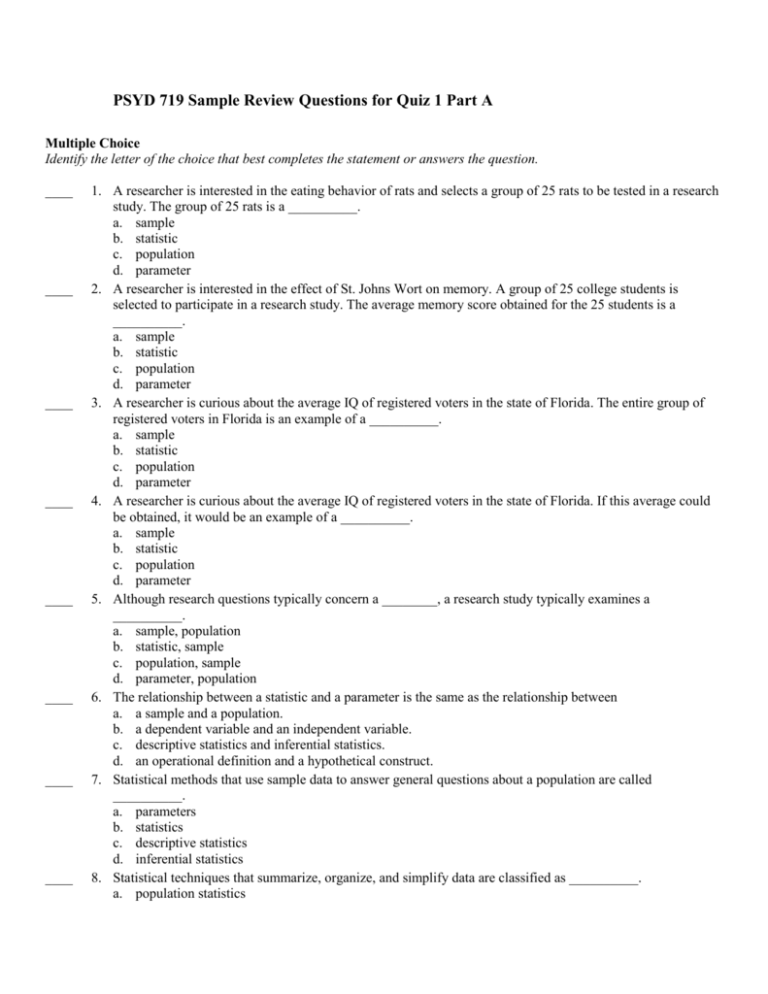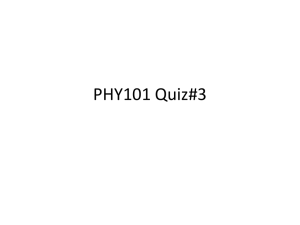mid-term review questions
advertisement

PSYD 719 Sample Review Questions for Quiz 1 Part A Multiple Choice Identify the letter of the choice that best completes the statement or answers the question. ____ ____ ____ ____ ____ ____ ____ ____ 1. A researcher is interested in the eating behavior of rats and selects a group of 25 rats to be tested in a research study. The group of 25 rats is a __________. a. sample b. statistic c. population d. parameter 2. A researcher is interested in the effect of St. Johns Wort on memory. A group of 25 college students is selected to participate in a research study. The average memory score obtained for the 25 students is a __________. a. sample b. statistic c. population d. parameter 3. A researcher is curious about the average IQ of registered voters in the state of Florida. The entire group of registered voters in Florida is an example of a __________. a. sample b. statistic c. population d. parameter 4. A researcher is curious about the average IQ of registered voters in the state of Florida. If this average could be obtained, it would be an example of a __________. a. sample b. statistic c. population d. parameter 5. Although research questions typically concern a ________, a research study typically examines a __________. a. sample, population b. statistic, sample c. population, sample d. parameter, population 6. The relationship between a statistic and a parameter is the same as the relationship between a. a sample and a population. b. a dependent variable and an independent variable. c. descriptive statistics and inferential statistics. d. an operational definition and a hypothetical construct. 7. Statistical methods that use sample data to answer general questions about a population are called __________. a. parameters b. statistics c. descriptive statistics d. inferential statistics 8. Statistical techniques that summarize, organize, and simplify data are classified as __________. a. population statistics ____ 9. ____ 10. ____ 11. ____ 12. ____ 13. ____ 14. ____ 15. ____ 16. ____ 17. b. sample statistics c. descriptive statistics d. inferential statistics A characteristic, usually a numerical value, that describes an entire population of scores is a __________. a. parameter b. statistic c. variable d. constant A characteristic, usually a numerical value, that describes a sample of scores is a __________. a. parameter b. statistic c. variable d. constant The average score for an entire population would be an example of a __________. a. parameter b. statistic c. variable d. constant Although samples are usually representative of the populations from which they are selected, you should not expect a sample statistic to be exactly equal to the corresponding population parameter. The natural differences that exist between statistics and their parameters is known as __________. a. statistical error b. inferential error c. sampling error d. parametric error Using letter grades (A, B, C, D, and E) to classify student performance on an exam is an example of measurement on a(n) __________ scale of measurement. a. nominal b. ordinal c. interval d. ratio Determining a person's age (in years) would involve measurement on a(n) __________ scale of measurement. a. nominal b. ordinal c. interval d. ratio Determining a person's occupation would involve measurement on a(n) __________ scale of measurement. a. nominal b. ordinal c. interval d. ratio Determining a person's reaction time would involve measurement on a(n) __________ scale of measurement. a. nominal b. ordinal c. interval d. ratio Classifying people according to gender (male/female) would involve measurement on a(n) __________ scale of measurement. a. nominal ____ 18. ____ 19. ____ 20. ____ 21. ____ 22. ____ 23. ____ 24. ____ 25. b. ordinal c. interval d. ratio To determine the size of the difference between two measurements, a researcher must use a(n) __________ scale of measurement. a. nominal b. ordinal or interval c. interval or ratio d. ratio After measuring a set of individuals, a researcher finds that Bob's score is three times greater than Jane's score. These measurements must come from a(n) __________ scale. a. nominal b. ordinal c. interval d. ratio After measuring two individuals, a researcher can say that Tom's score is greater than Bill's, but cannot specify how much greater. The measurements must come from a(n) __________ scale. a. nominal b. ordinal c. interval d. ratio In an experiment, the researcher manipulates the __________ variable and measures changes in the __________ variable. a. population, sample b. sample, population c. independent, dependent d. dependent, independent A researcher observed that preschool children playing in a red room showed more aggression than children playing in a blue room. For this study, what is the independent variable? a. preschool children b. color of the room c. amount of aggression d. the children's play In a study evaluating the effectiveness of a new medication designed to control high blood pressure, one sample of individuals is given the medicine and a second sample is given an inactive placebo. Blood pressure is measured for each individual. For this study, what is the dependent variable? a. the medication b. the placebo c. blood pressure d. the individuals given the medication Which of the following is not a continuous variable? a. time to solve a problem b. temperature c. height d. number of children in a family A variable that has an infinite number of possible values between any two specific measurements is called a(n) __________ variable. a. independent b. dependent c. discrete d. continuous ____ 26. A variable that consists of indivisible categories with no other scores existing between neighboring categories is called a(n) __________ variable. a. independent b. dependent c. discrete d. continuous ____ 27. An operational definition is used to __________ a hypothetical construct. a. define b. measure c. measure and define d. None of the other choices is correct. ____ 28. For the following scores, what is X + 1? Scores: 3, 0, 5, 2 a. 11 b. 14 c. 20 d. 32 ____ 29. For the following scores, what is ( X)2 ? a. b. c. d. Scores: 3, 0, 5, 2 20 38 100 400 Table 2-1 X 5 4 3 2 1 f 1 2 4 1 2 ____ 30. Refer to Table 2-1. For these data, N = __________. a. 5 b. 10 c. 29 d. cannot be determined from the table ____ 31. Refer to Table 2-1. How many individuals had a score of X = 2? a. 1 b. 2 c. 4 d. either 1 or 4 ____ 32. Refer to Table 2-1. The percentage of individuals with X = 2 is __________. a. 10% b. 20% c. 30% d. 40% ____ 33. Refer to Table 2-1. For these data, X is __________. a. 10 b. 15 c. 29 d. cannot be determined from the table ____ 34. What is the shape of the distribution for the following set of data? Scores: 1, 1, 1, 2, 3, 3, 3 a. symmetrical b. positively skewed c. negatively skewed d. rectangular ____ 35. Frequency distribution polygons are intended for use with a. either interval or ratio scales of measurement b. only ratio scales c. either nominal or ordinal scales d. only nominal scales ____ 36. Frequency distribution bar graphs are intended for use with a. either interval or ratio scales of measurement b. only ratio scales c. either nominal or ordinal scales d. only nominal scales The following table shows a frequency distribution of quiz scores. Table 2-2 X 5 4 3 2 1 f 6 5 5 3 2 ____ 37. Refer to Table 2-2. How many individuals took the quiz? a. 5 b. 15 c. 21 d. cannot be determined from the information given ____ 38. Refer to Table 2-2. If a score of X = 3 or higher is needed for a passing grade, how many individuals passed? a. 3 b. 11 c. 16 d. cannot be determined from the information given ____ 39. Refer to Table 2-2. What is the value of X for this distribution of scores? a. 15 b. 21 c. 73 d. 15(21) = 315 ____ 40. Refer to Table 2-2. How many individuals had a score of X = 2? a. 1 b. 3 c. 5 d. cannot be determined from the information given ____ 41. What is the value of the mean for the following set of scores? Scores: 1, 3, 5, 0, 1 a. 10 b. 5 c. 2.5 d. 2 ____ 42. What is the mean for the following set of scores? ____ 43. ____ 44. ____ 45. ____ 46. ____ 47. Scores: 1, 6, 10, 11 a. 4 b. 7 c. 8 d. 14 In a sample of n = 6, five individuals all have scores of X = 10 and the sixth person has a score of X = 16. What is the mean for this sample? a. M = 13 b. M = 11 c. M = 13.2 d. not enough information to find the mean A sample of n = 5 scores has a mean of M = 9. What is X for this sample? a. 9/5 = 1.80 b. 5/9 = 0.555 c. 5(9) = 45 d. cannot be determined from the information given A population of scores has X = 60 and a mean of = 12. How many scores are in this population? a. 5 b. 12 c. 60 d. cannot be determined from the information given A sample of n = 25 scores has a mean of M = 11. If each score in the sample is multiplied by 6, the new mean would be __________. a. 11 b. 6 c. 66 d. 150 After 5 points are added to every score in a distribution, the mean is calculated and found to be = 30. What was the value of the mean for the original distribution? a. 25 b. 30 c. 35 d. cannot be determined from the information given ____ 48. Which of the following is a property of the mean? a. changing the value of a score will change the value of the mean b. adding a constant to each score will add the same constant to the mean c. multiplying each score by a constant will multiply the mean by the same constant d. All 3 of the other choices are correct. ____ 49. The value of one score in a distribution is changed from X = 20 to X = 30. Which measure(s) of central tendency is (are) certain to be changed? a. the mean b. the median c. the mean and the median d. the mode ____ 50. What is the median for the following set of scores? Scores: 1, 3, 9, 10, 22 a. 6 b. 9 c. 9.5 d. 11 ____ 51. What is the median for the following set of scores? ____ 52. ____ 53. ____ 54. ____ 55. ____ 56. Scores: 1, 4, 6, 17 a. 4 b. 5 c. 6 d. 7 A distribution can have more than one __________. a. mean b. median c. mode d. None of the other choices is correct. For a distribution of scores, the mean is equal to the median. This distribution is most likely to be __________. a. symmetrical b. positively skewed c. negatively skewed d. impossible to determine the shape For a perfectly symmetrical distribution with = 30, the median would have a value __________. a. equal to 30 b. greater than 30 c. less than 30 d. cannot be determined from the information given For a negatively skewed distribution with a mode of X = 25 and a mean of M = 20, the median is probably __________. a. greater than 25 b. less than 20 c. between 20 and 25 d. cannot be determined from the information given The most commonly used measure of central tendency is __________. ____ 57. ____ 58. ____ 59. ____ 60. ____ 61. ____ 62. ____ 63. ____ 64. ____ 65. a. the mean b. the median c. the mode d. the range A professor records the academic major for each student in a class of n = 40. The best measure of central tendency for these data would be __________. a. the mean b. the median c. the mode d. Central tendency cannot be determined for these data. For an extremely skewed distribution of scores the best measure of central tendency would be __________. a. the mean b. the median c. the mode d. Central tendency cannot be determined for a skewed distribution In a population of N = 10 scores, the smallest score is X = 8 and the largest score is X = 20. The range for the population is __________. a. 11 b. 12 c. 13 d. cannot be determined without more information The value for the range is determined by __________. a. the extreme scores (both high and low) in the distribution b. the extremely high scores in the distribution c. the middle scores in the distribution d. all of the scores in the distribution The value for the interquartile range is determined by __________. a. the extreme scores (both high and low) in the distribution b. the extremely high scores in the distribution c. the middle scores in the distribution d. all of the scores in the distribution Which of the following deviation scores corresponds to the score that is farthest away from the mean? a. 0 b. 5 c. -5 d. -10 In a population with a mean of = 50, a score of X = 45 would have a deviation score of __________. a. 5 b. -5 c. 45 d. cannot be determined without more information The symbol SS stands for the __________. a. sum of squared scores b. sum of squared deviations c. sum of scores, squared d. sum of the deviations, squared Which of the following symbols identifies the sample variance? a. s b. s2 ____ 66. ____ 67. ____ 68. ____ 69. ____ 70. ____ 71. ____ 72. c. d. 2 Which of the following symbols identifies the population standard deviation? a. s b. s2 c. d. 2 A population of N = 10 scores has = 50 and = 5. What is the population variance? a. the square root of 5 b. the square root of 50 c. 10 d. 25 A sample of n = 5 scores has M = 20 and s2 = 4. What is the sample standard deviation? a. 2 b. 5 c. 16 d. the square root of 20 To compute sample variance, the value of SS is divided by __________. a. n b. N c. n 1 d. N 1 To compute population variance, the value of SS is divided by __________. a. n b. N c. n 1 d. N 1 A population has = 40 and = 8. If each score is divided by 2, the new standard deviation will be __________. a. 16 b. 8 c. 4 d. insufficient information, cannot be determined Degrees of freedom for sample variance are determined by __________. a. X 1 b. Q1 Q3 c. n 1 d. ____ 73. You must determine Q1 and Q3 to compute the __________. a. sum of squared deviations b. semi-interquartile range c. variance d. standard deviation ____ 74. What is the value of SS for the following set of scores? Scores: 1, 1, 1, 3 a. 3 b. 6 c. 12 d. 36 ____ 75. A sample of n = 4 scores has SS = 12. What is the standard deviation for the sample? a. 3 b. the square root of 3 c. 4 d. the square root of 4 ____ 76. What is the variance for the following population of scores? a. b. c. d. Scores: 2, 2, 2, 2 0 2 4 16 X 5 4 3 2 1 ____ 77. Refer to above Table calculate the SS = __________. a. 5 b. 10 c. 15 d. 20 mid-term review questions Answer Section MULTIPLE CHOICE 1. 2. 3. 4. 5. 6. 7. 8. 9. 10. 11. 12. 13. 14. 15. 16. 17. 18. 19. 20. 21. 22. 23. 24. 25. 26. 27. 28. 29. 30. 31. 32. 33. 34. 35. 36. 37. 38. 39. 40. 41. ANS: ANS: ANS: ANS: ANS: ANS: ANS: ANS: ANS: ANS: ANS: ANS: ANS: ANS: ANS: ANS: ANS: ANS: ANS: ANS: ANS: ANS: ANS: ANS: ANS: ANS: ANS: ANS: ANS: ANS: ANS: ANS: ANS: ANS: ANS: ANS: ANS: ANS: ANS: ANS: ANS: A B C D C A D C A B A C B D A D A C D B C B C D D C C A C B A A C A A C C C C B D REF: REF: REF: REF: REF: REF: REF: REF: REF: REF: REF: REF: REF: REF: REF: REF: REF: REF: REF: REF: REF: REF: REF: REF: REF: REF: REF: REF: REF: REF: REF: REF: REF: REF: REF: REF: REF: REF: REF: REF: REF: 4 5 3 5 4 5 6 5 5 5 5 6 19 20 18 20 18 20 20 19 13 13 13 17 17 16 16 24 23 33 33 34 33 44 38 41 33 33 33 33 55 OBJ: TYPE: www OBJ: TYPE: www OBJ: TYPE: www OBJ: TYPE: www OBJ: TYPE: www OBJ: TYPE: www OBJ: TYPE: www OBJ: TYPE: www OBJ: TYPE: www OBJ: TYPE: www OBJ: TYPE: www OBJ: TYPE: www 42. ANS: 43. ANS: 44. ANS: 45. ANS: 46. ANS: 47. ANS: 48. ANS: 49. ANS: 50. ANS: 51. ANS: 52. ANS: 53. ANS: 54. ANS: 55. ANS: 56. ANS: 57. ANS: 58. ANS: 59. ANS: 60. ANS: 61. ANS: 62. ANS: 63. ANS: 64. ANS: 65. ANS: 66. ANS: 67. ANS: 68. ANS: 69. ANS: 70. ANS: 71. ANS: 72. ANS: 73. ANS: 74. ANS: 75. ANS: 76. ANS: 77.ANS: B B C A C A D A B B C A A C A C B C A C D B B B C D A C B C C B A D A B REF: REF: REF: REF: REF: REF: REF: REF: REF: REF: REF: REF: REF: REF: REF: REF: REF: REF: REF: REF: REF: REF: REF: REF: REF: REF: REF: REF: REF: REF: REF: REF: REF: REF: REF: 55 55 56 56 61 61 59 59 63 63 66 73 73 74 67 65 68 83 84 85 86 86 89 93 91 91 93 93 91 101 96 84 90 93 91 OBJ: TYPE: www OBJ: TYPE: www OBJ: TYPE: www OBJ: TYPE: www OBJ: TYPE: www OBJ: TYPE: www OBJ: TYPE: www OBJ: TYPE: www







